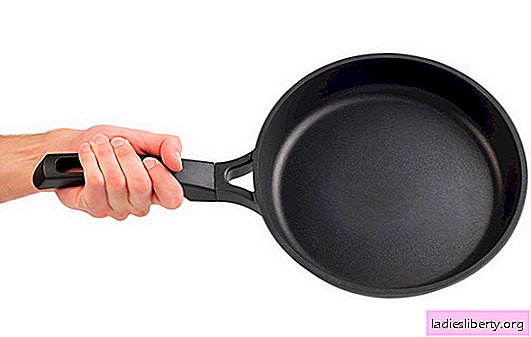
Nagar - appears on all pans during cooking.
Sooner or later, all people face him.
Moreover, this does not depend on the material of the pan, nor on the discipline of the hostess.
Removing it is quite difficult and long.
Not everyone has the patience and desire. Many people prefer to throw out a spoiled pan and buy a new one.
But this option does not suit thrifty housewives. To reduce the formation of soot, people buy pans with ceramic-granite and teflon coating. It does not insure against the formation of soot, but it will appear less often.
Its rapid formation on the protective coating is most often due to improper use and use longer than the warranty period. In addition to protection against carbon deposits, such pans have other advantages: it is convenient to cook food on them (thanks to the non-stick coating) and their weight is much lower than thick cast-iron pans.
They, like any other thing, have their drawbacks. So, the taste of food cooked in such a frying pan is “deformed”: the usual aroma and “roasted” flavor disappear. Another point: many doubt the safety of non-stick coating. Scientists from different countries even speak about its harm. For many housewives, this is a decisive factor in choosing a frying pan: many prefer cast iron instead of modern.
But both on a cast-iron and with a ceramic-granite coating, soot appears over time. And in order not to suffer for a long time and save time and effort, you need to learn how to wash the pan from soot. Below you will find step-by-step instructions and methods for cleaning the pan. But first you need to find out where he comes from.
How is carbon deposits formed?
Before you understand how to clean a pan, you need to know its causes. And also what he is. The deposit itself is a layer of black or brown. Outside, it is quite loose, and inside it is dense. In other words, soot is a burnt fat that has eaten into the surface of the pan after frying food.
It eats up gradually: after each use, burnt fat "grows" on the surface, forming a very dense layer. Sludge will be even if the pan is thoroughly washed after each cooking.
Not immediately, gradually it appears not only at the bottom, but also on the sides. A solid Oscalin is formed, which is very difficult to get rid of. It is necessary to periodically wash the pan and clean it of soot. Otherwise, you can soon lose your pleasant appearance and you can throw it away.
How to clean a pan and not spoil it
Before washing the pan from soot, you should consider the material from which it is made. Each metal requires its own care.
Aluminum pan
The thinnest material requiring special treatment is aluminum. To preserve the beautiful appearance of the dishes and not to spoil it when cleaning, you should follow some recommendations:
1. Do not clean carbon deposits with metal-base sponges and hard brushes, as they leave scratches when cleaning. Coarse salt, sand and sandpaper can also damage the metal.
2. Do not use products containing acid and alkali in their composition. Otherwise, dark spots will remain in the pan and it will lose its original shine.
3. It is best to wash off the newly formed fat by hand. In the dishwasher, the pan will darken and tarnish.
You can clean the pan with: citric acid, soda, soda ash and silicate glue.
Stainless steel
Since this metal is capricious and when using powder and chemicals, scuffs, scratches and stains can remain, you can wash the pan from carbon deposits in folk ways:
- using table salt (preferably well chopped): sprinkle half a cup on the bottom and leave for 2 hours. Then rinse with warm running water.
- Outside carbon deposits are removed using soda. She needs to grease a frying pan with a thick layer and leave for several hours. Sludge softens and can be easily washed with water or a damp sponge.
- activated carbon: turn a few tablets into powder and mix with water. Then apply the resulting mass to the surface, leave for half an hour - an hour. Then rinse with cleaning agent.
How to wash a pan from carbon deposits: tools and step-by-step instructions
There are two methods to clean the pan: using household cleaning products and folk methods. Each of them has its own advantages and the choice is solely for the hostess.
Household chemicals
Conventional fat eliminators can do a good job of removing carbon deposits. The main thing is to be able to use them. Household chemicals are best used for prevention, as it is easier to prevent the appearance of burnt fat than to remove it.
The most popular are conventional detergents. You can use both brand names (for example, AOS, Mr. Muscle, Fairy and others), as well as cheaper products.
However, household chemicals are not entirely safe for humans. "Respect for the skin," cause great suspicion among scientists. In addition, there is no guarantee that the detergent is completely washed from the dishes. There is one more “but”: if you buy a cleaning product specifically for removing carbon deposits, then it will be too “aggressive”. It can not be used for simple washing dishes.
If this does not scare, then when applying household chemicals, it is worth observing the safety rules. When applying cleaning agent, rubber gloves should be worn. To protect the respiratory tract, you must use a respirator. But if this seems superfluous, during cleaning, you should well ventilate the kitchen or turn on the hood at full power.
How to clean a cast iron pan
Cope with charred fat can not only household chemicals, but also simple folk remedies. True, many of them are extreme. But do not be afraid, as these methods were used long before the appearance of cleaning products. The results were always excellent.
The first such way: heat the pan with a blowtorch. Doing this procedure is necessary exclusively on the street. Just in case, you need to move away from the buildings to make sure that there are no people or animals nearby.
It is best to ask a man for help. Women will only need to hold the handle of the pan on their outstretched arm. The rest of the work will be done by a man: he will turn on a blowtorch and direct fire at that part where there is a deposit. Keep the pan on fire for 5-7 minutes and the burnt fat will disappear by itself.
Frying pan heating. Do not feel like tormenting with a blowtorch? Then you can try another way. You can put the pan on medium heat and leave for several hours. For best results, pour clean sand into the pan. But this method has one minus: there will be a lot of smoke and a strong burning smell will appear. But the result will be just great: the pan will look like new.
Just as with a blowtorch, it is necessary to clean the pan from soot in an open area. After the procedure, you need to lightly knock on the pan, and the burnt fat will disappear by itself.
Vinegar. To wash the pan from carbon deposits can help table vinegar. First you need to dilute vinegar with water in a ratio of 1: 3. The resulting concentrate is poured into the pan. After that, leave the pan over low heat for three to five hours. It is necessary to periodically add the concentration to the pan, since when it boils, it will gradually evaporate.
After that, it will be very easy to clean the pan: just scrape it off with a stiff brush. This method has a single negative point. Everything smells like vinegar: both the room and the frying pan. The apartment will have to be thoroughly ventilated, and it is better to boil the pan with soda and lemon juice.
Activated carbon. In a coffee grinder, make powder from 15 tablets. Moisten the pan, pour the powder on top. After that, rinse with an ordinary cleaner after one hour.
Soda ash. This method was used in the Soviet Union. First you need to draw water into a large tank. Then grate the laundry soap, mix it with soda ash and add 100 grams of silicate glue. All this is added to the tank with prepared water. Then immerse the pan in it, put on fire. Keep the tank on fire for 30 minutes. After that, it is very easy to wash the pan from carbon deposits.
How to wash a pan from carbon deposits: Teflon pan
Most modern pans are sold with non-stick coating. They are convenient to use and practically do not burn. Most often, soot in such pans appears when it is overheated. But even if all the operating rules are followed, it will still appear, so you should know how to wash the pan from carbon deposits with non-stick coating.
There is a good way to clean burnt fat in ceramic-granite, ceramic and Teflon pans. The only warning: it should be cleaned very carefully.
Boil in solution. To create a solution for removing carbon deposits, you need to mix several ingredients: a cleaning agent, soda ash and water. Dishwashing liquid should be about 200 grams (or one third of a glass). Soda ash should be three handfuls typed on the tip of a knife. Soda and product must be added to hot water. After that, a frying pan is launched into the resulting solution and put on fire. Boil for 30 minutes. This solution will gently and gently remove carbon deposits without damaging the pan.











